The estimation of environmental and genetic parental influences
- PMID: 36524242
- PMCID: PMC10272284
- DOI: 10.1017/S0954579422000761
The estimation of environmental and genetic parental influences
Abstract
Parents share half of their genes with their children, but they also share background social factors and actively help shape their child's environment - making it difficult to disentangle genetic and environmental causes of parent-offspring similarity. While adoption and extended twin family designs have been extremely useful for distinguishing genetic and nongenetic parental influences, these designs entail stringent assumptions about phenotypic similarity between relatives and require samples that are difficult to collect and therefore are typically small and not publicly shared. Here, we describe these traditional designs, as well as modern approaches that use large, publicly available genome-wide data sets to estimate parental effects. We focus in particular on an approach we recently developed, structural equation modeling (SEM)-polygenic score (PGS), that instantiates the logic of modern PGS-based methods within the flexible SEM framework used in traditional designs. Genetically informative designs such as SEM-PGS rely on different and, in some cases, less rigid assumptions than traditional approaches; thus, they allow researchers to capitalize on new data sources and answer questions that could not previously be investigated. We believe that SEM-PGS and similar approaches can lead to improved insight into how nature and nurture combine to create the incredible diversity underlying human behavior.
Keywords: genetic nurture; heritability; nature and nurture; parental effects; vertical transmission.
Conflict of interest statement
Figures





References
Grants and funding
LinkOut - more resources
Full Text Sources

